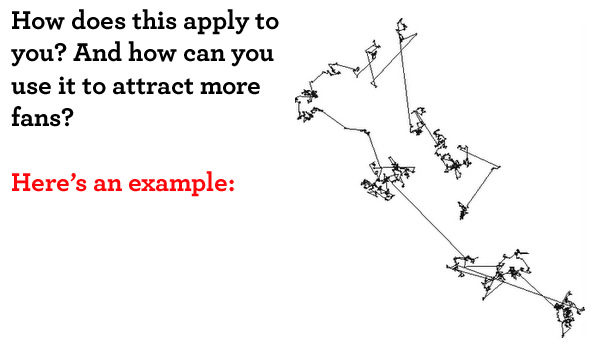A Realistic, Chaos-Based Theory on Converting Cume to Fans

It’s the Holy Grail of radio programming: “If we could just find a way to convert more of our reach into loyal, passionate P1’s, we’d dominate ratings.”
Nurturing relationships with listeners takes time, of course, and it’s not easy to convince listeners to fall in love with us.
But other than wringing your hands, wishing and hoping for the survey gods to smile on you each month, what can you do?
Here’s a unique approach, based on a mathematical concept that appears in nature and increasingly in marketing, advertising and social media.
Here’s how it works in nature:
A foraging animal tends to stay in a relatively small area, hunting for food or grazing on grass. When it has used up the source of food, it will move on in a seemingly random direction searching out their new spot. And so on.
However, when you study it in greater detail, it is not nearly as random as it first appears. The pattern is called the Levy Flight, named after founder Paul Levy. It’s a complex formula that can be summarized as:
A random walk in which the steps are defined in terms of the step-lengths, which have a certain probability distribution, with the directions of the steps being isotropic and random.
Confused? Yeah, me too. Suffice to say that the Levy Flight puts definition to what seems to be a chaotic, random pattern.
When you plot the Levy flight, it looks like this:

Someone discovers your radio show by hitting scan on their car radio or being in a car with a friend that has your station on. They like what they hear and start tuning in on their own, perhaps even setting one of their own presets to your station. They return again and again. They may not befans yet, but are heavy users. You’re gaining momentum with this listener. Then, one day, they feel as though there is no more benefit to them. They’ve heard everything you have to offer. The show sounds the same day after day. When the benefit is gone, they move on, looking for something fresh and different. Hunting for food in a new place. If that one listener happens to have a meter or diary, you have a big problem on your hands.
The same happens online. They discover your website or social media platform. They may even interact and return again and again. Eventually, they become bored or feel the excitement isn’t as great, and they move on.
And it happens in your real life, too. How many times have you discovered a new restaurant. You love it, and go back with friends. You may even become regulars for awhile. Then, you start browsing again, lured by another “new”.
What Can You Do?
- Content. Never stop creating. Never stop innovating. Never stop evolving. Stay consistent, of course, but just as Disney constantly updates their attractions, your show should be a living, breathing evolution of entertainment.
- Focus on Fans. A fan – a listener who waves your flag – has great value, and you don’t need that many to win the ratings battle. Identify the type of listeners (demographic, geographic, psychographic) that should be your primary target. Craft your position, personality and marketing messages to attract them to yourcharacter brand.
- Communication. Your audience doesn’t leave to get food they need to stay alive. They seek relief from boredom. And just as restaurants lose your loyalty when they become less top-of-mind, it’s critical to stay in touch with listeners, especially those individuals that make up the majority of your quarter hours. That’s why a database strategy should be an important part of your marketing plan.
Understanding the nuances of consumer behavior changes how you view the challenge of increasing brand loyalty. It’s not a race to the biggest cume, most Facebook fans or the most video views. It’s about finding those 1,000 that will make up the core of your future success.


